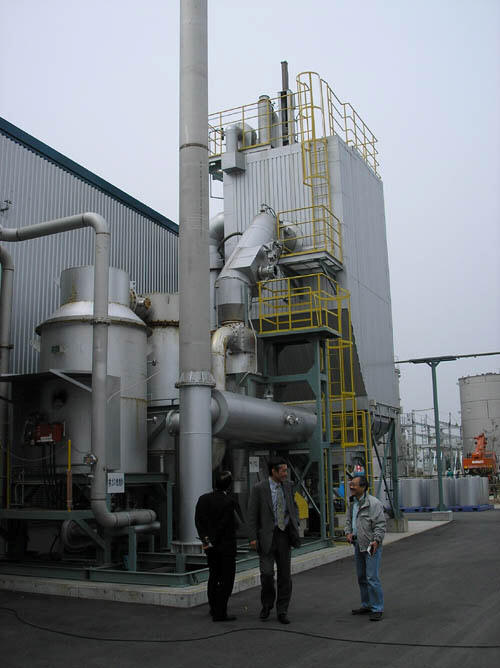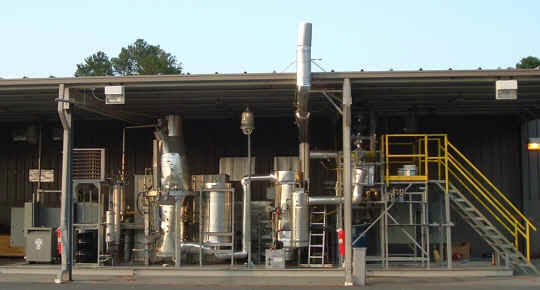| Slash and Char |

|

|

|
Page 5 of 5
On a global scale, crop residue biomass represents a considerable problem as well as new challenges and opportunities. Before the green revolution and the introduction of mineral fertilizers, crop residues were a valued resource and mostly either returned to the soil as organic fertilizer or used for various other purposes (fuel, fodder, building material, others). Since then, the importance of these uses declined continuously, mainly because of the availability of cheap inorganic fertilizer and the increasing opportunity costs of organic fertilizer use. Simultaneously, increasing yields lead to ever greater quantities of residues available and intensification of land use resulted in less and less decomposition time between cropping seasons for managing them. Therefore, many farmers find it more expedient to burn crop residues than to incorporate them into the soil. The field burning is causing severe air pollution.
 Currently most biomass conversion systems produce either charcoal (mainly in Japan as waste management) or energy through complete biomass gasification (Güssing GMBH, Austria, Choren, Germany. Incomplete gasification results in charcoal production. Currently most biomass conversion systems produce either charcoal (mainly in Japan as waste management) or energy through complete biomass gasification (Güssing GMBH, Austria, Choren, Germany. Incomplete gasification results in charcoal production.
A system converting biomass into energy (hydrogen-rich gas) and producing charcoal as a by-product (Day et al. 2005) might offer an opportunity to address these problems. Charcoal (bio-char, agri-char) can be produced by incomplete combustion from any biomass and it is a byproduct of the pyrolysis-technology used for biofuel and ammonia production. This establishes the possible link of this technology to crop residues in general and the now widespread new interest in bioenergy. Energy from crop residues could lower fossil energy consumption and CO2-emissions, and become a completely new income source for farmers and rural regions. Linking energy production with charcoal production results in 30.6 kg C sequestration for each GJ of energy produced. The bio-char byproduct of this process could serve to recycle nutrients, improve soils and sequester carbon. A review by Lehmann et al. (2006) and the article “Black is the new green” (Marris 2006) emphasise the potential of bio-char on a global scale. A global analysis revealed that up to 12% of the total anthropogenic C emissions by land use change (0.21 Pg C) can be off-set annually in soil, if slash and burn is replaced by slash and char. Agricultural and forestry wastes such as forest residues, mill residues, field crop residues, or urban wastes add a conservatively estimated 0.16 Pg C yr-1. Using published projections of the use of renewable fuels in the year 2100, bio-char sequestration could amount to 5.5-9.5 Pg C yr-1 if this demand for energy was met through pyrolysis, which would exceed current emissions form fossil fuels (5.4 Pg C yr-1). Bio-char soil management systems can deliver tradable C emissions reduction, and C sequestered is easily accountable, and verifiable. The described mixture of driving forces and technologies has the potential to use residual waste carbon-rich residues to reshape agriculture, balance carbon and address nutrient depletion.
Further Literature:
Day D, Evans R J, Lee J W and Reicosky D 2005 Economical CO2, SOx and NOx capture from fossil-fuel utilization with combined renewable hydrogen production and large-scale carbon sequestration. Energy 30, 2558-2579
Lehmann J, da Silva Jr J P, Rondon M, Cravo M d S, Greenwood J, Nehls T, Steiner C and Glaser B 2002 Slash and char - a feasible alternative for soil fertility management in the central Amazon? In 17th World Congress of Soil Science, Bangkok, Thailand, 14. - 21. 08. 2002, 2002. Ed T I U o S Sciences. pp 1-12.
Lehmann J, Gaunt J and Rondon M 2006 Bio-char sequestration in terrestrial ecosystems - a review. Mitigation and Adaptation Strategies for Global Change 11, 403-427
Mann C C 2002 The Real Dirt on Rainforest Fertility. Science 297, 920-923
Marris E 2006 Black is the new green. Nature 442, 624-626
Steiner C, Teixeira W G, Lehmann J and Zech W 2004a Microbial Response to Charcoal Amendments of Highly Weathered Soils and Amazonian Dark Earths in Central Amazonia - Preliminary Results. In Amazonian Dark Earths: Explorations in Space and Time. Eds B Glaser and W I Woods. pp 195-212. Springer Verlag, Heidelberg.
Steiner C, Teixeira W G and Zech W 2004b Slash and Char: An Alternative to Slash and Burn Practiced in the Amazon Basin. In Amazonian Dark Earths: Explorations in Space and Time. Eds B Glaser and W I Woods. pp 183-193. Springer Verlag, Heidelberg.
|
|||||||
| < Prev |
|---|
